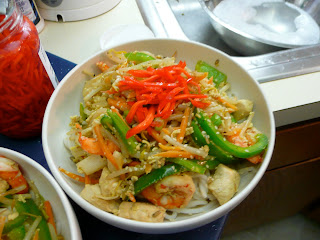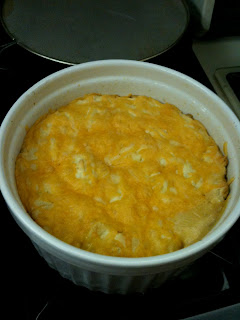Casseroles are such great winter dinners. You can usually put one together fairly quickly, throw it in the oven, and go take a load off while it bakes into a wonderful warm treat. Unfortunately, Gma's recipe box only contains about five casserole recipes, three of which are for the exact same thing (I'm really not sure why, but then I very strongly disliked that seven-layer casserole when I was a kid, possibly because I hadn't yet learned to love green peppers, so it's no mystery why I wouldn't have kept three copies!).
Fortunately, one of the other recipes is for Dry Beef Casserole, a dish I'd completely forgotten until I found the recipe a week or so ago. Dry beef is the same thing as chipped beef (I'm guessing the nomenclature is regional, but I'm not sure), but you don't always have to put it in a gravy. I'm not sure that we had the casserole all that often, but since I remember it, it must've made an impression, and not a bad one.We used to be able to find it at the deli--or perhaps it was the farmer's market in downtown York, where you shopped by food type. The fact that I just plain don't like steak probably means I'll never be considered a true carnivore, but the stands at market had some amazing things that I can't find in New Jersey, like dry beef, butcher bologna, and Lebanon sweet bologna, which is to Oscar Meyer what Ferrari is to Chevrolet. They are so different as to be almost completely unrelated. (I've been able to find Lebanon bologna in one or two stores here, but the only way to get dry beef is in a pouch in the cold cuts section of the dairy case, and some stores don't even have that--they just sell the pre-made dry beef gravy. And I think I would faint if I found butcher bologna, though I sure wouldn't mind.)
I whipped up some dry beef casserole this evening, and it's currently sitting in the fridge, as per the recipe, but I figure I'll let you in on the process so far, and will report back tomorrow night after I've sampled the results.
Dry Beef Casserole
1 can condensed cream of mushroom soup
1 cup milk
1 cup finely cut cheddar cheese (about 1/4 pound)
1 cup uncooked elbow macaroni
3 tablespoons finely chopped onion
1/4 (4 oz) pound dried beef, cut in bite-size pieces
2 hard-cooked eggs, sliced
Stir milk into soup. Add remaining ingredients, folding the eggs in last. Turn into a buttered 1.5 quart baking dish. Store covered in refrigerator at least 3-4 hours or overnight. Bake 1 hour uncovered at 350. Serves 6.
This recipe is clipped from the newspaper and credited to a Mrs. Ronald Cosgrove of York. It's also in a fundraising recipe collection sold to benefit the York Symphony back in 1980, in two variations. One says to dice the cheese, which might be better (I used finely grated cheese, thinking that's what "finely cut" meant, but I could be wrong), and another uses slightly different proportions.
The latter also addresses a question I had when looking at these recipes--shouldn't there be some sort of topping? It seems to me that it'll look awfully naked otherwise. The second variation says to top the dish with buttered bread crumbs, and I'm probably going to top mine with bread crumbs and maybe a little leftover cheese, just for decoration. I also just tore the beef into small pieces, which seemed easier and maybe even more fun. I wasn't sure just how big a dish I was going to need, since I tend to think in inches rather than quarts, but it fit in an 8x8 Pyrex dish just fine. It took about five minutes to put the whole thing together, not counting the time to boil the eggs.
Here's what it looks like right now:
Tomorrow night, I'll top it and toss it in the oven for an hour so it's ready when Linda comes over to watch
Ice Station Zebra, which should be an adventure in itself. Stay tuned!
 I apologize for letting this blog sit idle for so long, but things have been busy lately and cooking has mostly consisted of easy things from sources like Everyday Food or things I've already cooked here. Hopefully, that'll change soon. I'm sorry that I couldn't offer this recipe in time for Thanksgiving, but I really didn't need two, and I didn't want to let one sit for days before Thursday's feast. Christmas, perhaps?
I apologize for letting this blog sit idle for so long, but things have been busy lately and cooking has mostly consisted of easy things from sources like Everyday Food or things I've already cooked here. Hopefully, that'll change soon. I'm sorry that I couldn't offer this recipe in time for Thanksgiving, but I really didn't need two, and I didn't want to let one sit for days before Thursday's feast. Christmas, perhaps?



















